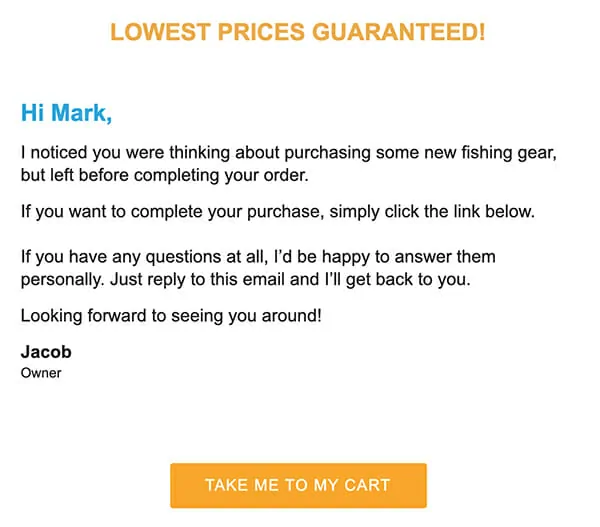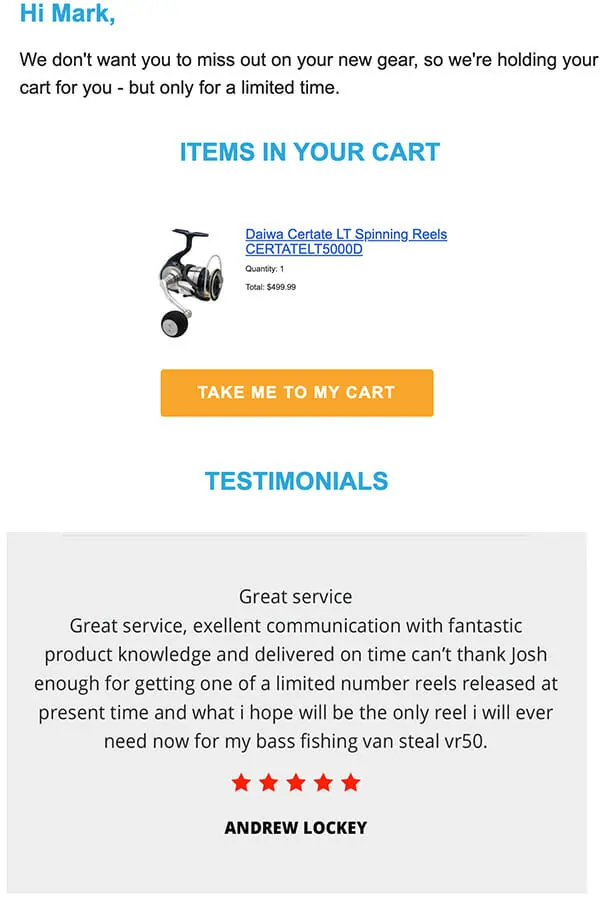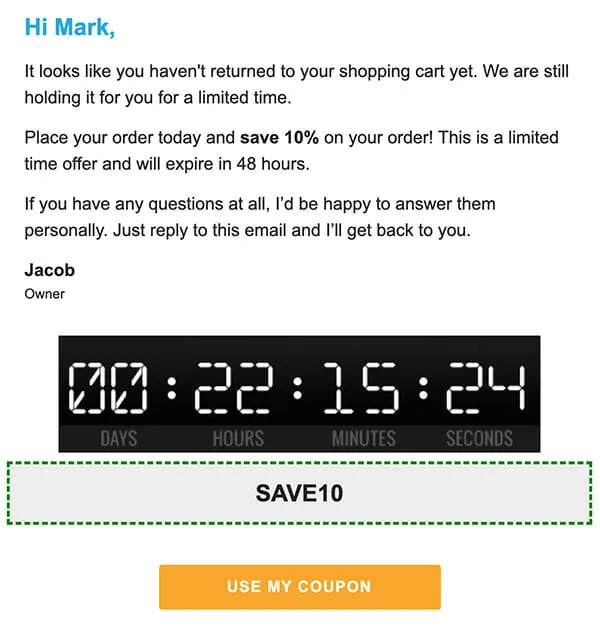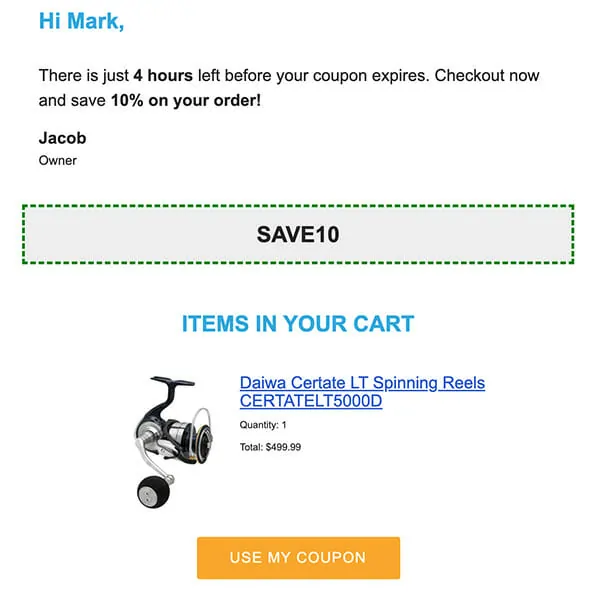 Photo From Adobe Stock
Photo From Adobe StockOriginally Posted On: https://taggartmediagroup.com/blog/email-marketing/these-4-abandon-cart-emails-have-generated-95822-95/
“Hi Mark – did you forget something?”
Mark received this email because he had abandoned his cart for one reason or another (life happens). Over the course of the next 3 days, Mark received 3 more emails from my automated cart abandonment email sequence.
Fast forward to today, I’ve sent out this email sequence hundreds of times and have generated over $95,822.95 (and counting) for just one of my eCommerce clients, who sells fish and tackle gear.
Beating Cart AbandonmentCart abandonment happens when shoppers add items to their cart with some intent of making a purchase, but leave the website without going through the entire checkout process.
On average, cart abandonment for eCommerce sites is 69%, meaning, that nearly 7 out of 10 potential buyers abandon their cart.
The result?
eCommerce stores lose nearly $18 billion every year!
However, cart abandonment is inevitable for all sites, but there is a proven way of giving your business the best chance of recovering these potential customers.
This is through a cart abandonment automated email sequence and really, what is better than automatically recovering sales for your business, even if you are asleep?
This guide explains the entire process, step-by-step, along with email templates that you can use for your own eCommerce store and potentially generate hundreds of thousands of dollars that could’ve been lost due to cart abandonment.
Let’s dive in.
The First Email: The ReminderSo the first email is incredibly simple, yet it is one of the most effective emails I’ve ever sent out. Let’s start with the subject line.
Subject Line: Hi Mark – did you forget something?So there are a couple of things that stand out immediately, personalization by using the first name of the abandoner and the fact that the email is implying they might have forgotten about their cart or simply got distracted with life, when they were going through the checkout process.
The reality is that cart abandonments happen for a variety of reasons and that is why I like to start with just a simple friendly reminder. It still amazes to me how often this happens and how well this simple reminder converts.
Now let’s focus on the name first. What is critical for this sequence is that when you are collecting customers and potential customers contact information, that no matter what, you collect their first name.
Yes, personalization in emails isn’t new in 2020, but it is still one of the most effective conversion strategies. In fact, personalizing emails was one of the tactics the Obama campaign team used for emails during the 2012 campaign.
Needless to say, the campaign was successful but more importantly, the email campaign was so successful that nearly a decade later, strategies built on the same fundamentals are still being used by politicians, including in the 2020 elections.
It’s hard to convey how strong the urge is to open or view an email is when it’s for you. The reality is that your customers don’t care about you or your business, but they care about what you and your business can do for them.
This natural urge and curiosity is compounded by the second part of the subject line – “Did you forget something?”
The second part of the subject line implies that you’ve indeed forgotten something and this email is a reminder.
So the person opens the email.
The BodyGetting the email opened is just the first step, you also need to convince the buyer to take action (visit the website, buy something, download something, etc). Example below:

The body of the email is very important. I’ve used short sentences because long-paragraphs can be a death sentence for emails. Think about your own email habits and processing unopened emails.
My guess is that you are like me and move as quickly as possible to get to inbox 0. If you love collecting unread emails you might want to see a therapist 
I also don’t mince words – I get right to the main part of reminding the customer that they left their cart and more importantly, I remind the customer that the owner of the business is here to answer any questions they have personally.
If possible, it is a good idea to humanize your brand and give it a “face.” This has been shown to establish trust.
And if the customer got distracted and simply forgot to checkout, this email does a good job of being a reminder as well.
Why This Email Works?Here are the key takeaways from the first email:
1. PersonalizeI am a strong believer in personalizing emails and personalization is going to be a common theme in many of my emails because I’ve seen its effectiveness first-hand.
2. TimingThis email was sent exactly 4 hours after cart abandonment so everything was still fresh in the customer’s mind. They most likely will still want that fishing gear and it isn’t too late for the owner to answer any of their questions.
3. DirectnessKeep it simple, easy to understand and clear of what action they took that triggered this email (abandoning their cart)
4. 2-Way CommunicationThe email offered a quick and easy way for the customer to contact the owner.
The Second Email: Social ProofHumans have a herd mentality – we do what others do because it has helped us survive for thousands of years and we haven’t let go of this habit just yet.
The second email is sent out 20 hours after the first email (or 24 hours after cart abandonment) and is aimed to tap into the customer’s herd mentality.
Subject Line: “They have great customer service and they will price match!”I know what you’re thinking – where is Mark?
Well, Mark isn’t in the subject line this time because we A/B tested this email with one email being sent out with the customer’s name and the other one having just a part of a testimonial in quotes.
The latter (testimonial in quotes) generated 143% more revenue than the email with the personalized subject line.
And I have a pretty solid theory as to why this happened.
20 hours ago they received an email with a personalized subject line. If Mark received another email with a similar subject line, he might’ve thought that it was the same email with the same content and never opened the email.
This change up in the subject line keeps it from feeling spammy, while creating social proof and curiosity at the same time.
The BodyThe subject line is just to get the recipient to open the email. The real work begins with the body of the email.
The main purpose of this email was to touch on any worry from potential customers, especially if they haven’t purchased from the site before. So we leveraged past customer testimonials.
Here’s what the body of the email looked like:

The email also contained a list of the items the customer currently has in their cart.
In the body, we also added an element of time by saying that we’re holding their cart for a limited time only. This works especially well if the item they were looking at was almost out of stock or in high demand.
Why This Email WorksHere are the key takeaways from the second email:
1. TimingTiming is crucial for this cart abandonment email. We want to give the customer enough time to think about their new products, but also want to send it just before they completely forget about it or before they buy the product from a competitor.
During our testing, we found that sending it any time before 20 hours was too short of a time period and more often than not, the customer didn’t open the email.
2. Different Subject LineAgain, the key with any email is to get it opened. A personalized (Hi, Mark) subject line similar to the first email didn’t perform anywhere as well as a completely new subject line with a quote from a testimonial and also creates curiosity.
3. The BodyThe first few lines of text, the testimonials, and the snapshot of the cart did three things – created a sense of urgency (“for a limited time”), activated the herd mentality of the human mind (testimonials), and reminded the customer of their desires (their cart).
Email 3: The Coupon2 emails and 3 days after the cart abandonment, I sent out the third email in this sequence – an email with a coupon because who doesn’t like a discount?
With the past emails, we gave our customers a chance to clear any doubts they might have and also showed them what other customers think about purchasing on the site.
And if they still haven’t made a purchase, it’s safe to assume that the price might be playing a part here. So in the third email, we offered them a 10% discount coupon.
Subject Line: FIRST NAME – how about 10% OFF your cart?We again A/B tested subject lines with non-personalized and personalized subject lines and personalized emails came out on top. This was likely because of the time gap between the second and third email.
But this time, the second part of the subject line was far more important than the personalized greeting. Without wasting any time, we let the customer know that we’re giving them a discount on their order.
Remember, the main purpose of the subject line is to get the customer to open the email. Click-through rates and conversions come with the body of the email.
The BodyThe human attention span is very short which means short paragraphs will almost always be more effective when delivering a sales pitch (or sales message).
Keeping that mind, in the body of this email, we’ve included three very short paragraphs, each carrying a different message.
The first paragraph is the intro and lets the customer know instantly that this email is about their shopping cart. This in combination with the direct subject line is enough for the customer to figure out what this email is about.
But we’re not done yet.
In the second paragraph, we introduce the sentence “This is a limited time offer and will expire in 48 hours.”, creating a sense of urgency that provokes action.
The final paragraph is yet another attempt to open a two-way dialogue with the customer in case they have some doubts.

Apart from the text, we’ve also included a few design elements, the most obvious of which is the countdown timer gif and of course, the coupon itself.
Why This Email Works?Here are the key takeaways from the third email:
1. IncentiveThere are two big reasons why this works and the first reason is, of course, the incentive. Financial incentives are very strong and I have no doubt that this 10% discount was crucial in the success of this email sequence, generating nearly $100,000 in sales
While I am on the topic of incentives, it’s important to know your audience. If you’re selling a luxury item (or something similar), beware of discounts because too many discounts might devalue the brand in the eyes of the customer.
2. UrgencyThe second reason this email works is because of the limited offer. We decided on 48 hours because we wanted to create a sense of urgency but give the customer more than enough time to take action.
But what if the customer is busy when he receives the email and forgets about it? That’s what the final email is for.
Email 4: The Final Offer ReminderLast call.
The final email in this email sequence is meant to remind customers who might’ve forgotten to use the coupon or missed the third email altogether.
Subject Line: FIRST NAME – Just 4 hours left to use your coupon!This too has a personalized subject line because it performed well during A/B testing. True to the other emails, we’ve kept the subject line as direct and as intriguing as possible.
But unlike the other emails, this email creates a sense of urgency right in the subject line instead of the body because it really is very urgent.
In 4 hours, the customer will miss their chance to save 10% on their order.
The BodyNo hard-sell on the last email (we did that in the third email). If the customer saw and ignored the previous email, they’re highly unlikely to simply change their mind this time (though possible).
So instead, this email is meant for two audiences. First, those who wanted to make a purchase but forgot to do so and second, those who missed the third email.

Here are the key takeaways from the fourth email:
1. Timely reminderWe found four hours to be the sweet spot for reminders. Four hours created a sense of urgency while giving customers just enough time to make that purchase, especially if they are at work.
2. Short and sweetAs I said, there’s no point in another hard-sell in the final email and risk coming off as annoying or forceful. As eCommerce store owners, you did everything you could, now let the customer make a decision. Keep the email short and sweet.
Wrapping Up…There you have it – 4 cart abandonment emails that you use for your own eCommerce store and automate them to ensure you get as many customers as you can back to their carts. If you have any questions at all, feel free to contact us.
